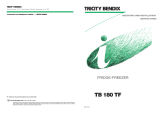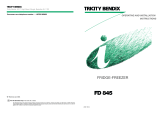
Safety Precautions
20
DISPOSAL INSTRUCTIONS – OUR ENVIRONMENT POLICY
Our refrigerators are only packaged using non-pollutant, environment-friendly, recyclable materials. We urge you to
cooperate by disposing of the packaging properly. Contact your local dealer or the competent local organisations for
the addresses of collection, recycling and disposal facilities.
Never leave all or part of the packaging lying around. Packaging parts, and especially plastic bags, may represent a
suffocation hazard for children.
Your old appliance must also be disposed of properly.
Important deliver the appliance to your local organisation authorised to collect scrapped appliances. Proper
disposal allows the intelligent recovery of valuable materials. Refrigeration appliances contain gases which may
damage the environment; it is important to ensure that the refrigeration circuit pipelines are not damaged until the
competent service has taken delivery of the appliance.
Before scrapping your refrigerator it is important to remove doors and leave shelves in position as for use, to ensure
that children cannot accidentally become trapped inside during play. Also, cut the power supply lead and remove it
and the plug.
1. SAFETY PRECAUTIONS
NOTICE TO USERS:
PURSUANT TO DIRECTIVES 2002/95/EC, 2002/96/EC, 2003/108/EC, RELATING TO THE
REDUCTION OF THE USE OF HAZARDOUS SUBSTANCES IN ELECTRICAL AND ELECTRONIC
EQUIPMENT, AND WASTE DISPOSAL, THE BARRED RUBBISH BIN SYMBOL ON THE APPLIANCE
INDICATES THAT IT CANNOT BE DISPOSED OF AS HOUSEHOLD WASTE AT ITS END-OF-LIFE.
THE USER MUST THEREFORE HAND THE PRODUCT OVER, AT ITS END-OF-LIFE, TO THE
APPLICABLE COLLECTION CENTRES FOR THE RECYCLING OF ELECTRICAL AND ELECTRONIC
WASTE, OR RETURN IT TO THE DEALER ON PURCHASE OF ANOTHER EQUIVALENT
APPLIANCE, ON A ONE-FOR-ONE BASIS. CONSIGNING THE END-OF-LIFE APPLIANCE TO THE
APPROPRIATE COLLECTION POINT FOR RECYCLING AND ECO-COMPATIBLE TREATMENT AND
DISPOSAL PREVENTS POTENTIAL NEGATIVE EFFECTS ON THE ENVIRONMENT AND HUMAN
HEALTH, AND HELPS ENSURE THAT THE PRODUCT’S COMPONENT MATERIALS WILL BE
RECYCLED. UNLAWFUL DISPOSAL OF THE PRODUCT BY THE USER MAY LEAD TO
PROSECUTION.
Keep the instruction handbook in a safe place; it contains important information which must be applied
when installing, using and servicing the refrigerator. The handbook must be kept so that it can be passed
on to any subsequent owners of the appliance.
The manufacturer declines all responsibility in case of failure to comply with the following precautions:
- This appliance is not intended for use by persons (including children) with reduced physical, sensory
or mental capabilities, or lack of experience and knowledge, unless they have been given supervised
or instruction concerning use of the appliance by a responsible person for their safely.
- Young children should be supervised to ensure that they do not play with the appliance.
- Do not attempt to operate a damaged appliance: in case of doubt, contact your dealer.
- If the supply cord is damaged, it must be replaced by manufacturer or its service agent or a similarly
qualified person in order to avoid a hazard.
- The appliance must be installed and connected to the electrical mains in full compliance with the
instructions provided in the handbook. The electrical connection conditions must be as specified on
the nameplate , which is in the bottom left-hand corner of the body of the refrigerator. The
appliance's electrical safety is only guaranteed if the household electrical system is earthed in
accordance with the relevant regulations.
- Make sure that all repairs and servicing are only carried out by authorised engineers from the
Smeg after-sales service. Always disconnect the appliance from the electrical mains in case of
breakdown and maintenance, when changing light-bulbs or during cleaning. Never defrost using
electrical devices or steam cleaners. Never remove frost or ice with sharp items, as this may cause
irreparable damage to the walls of the refrigerator.


















